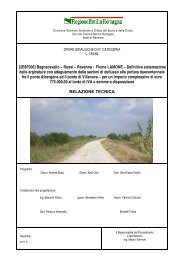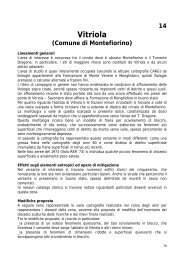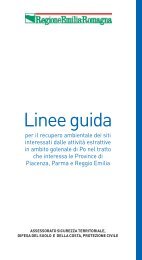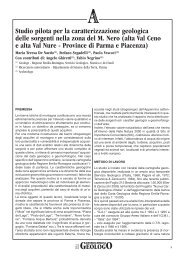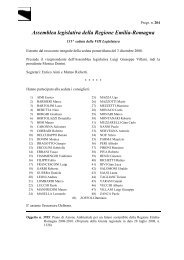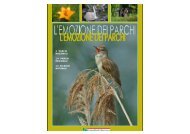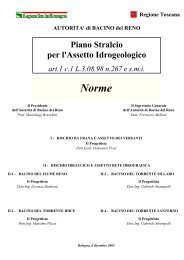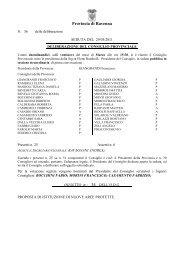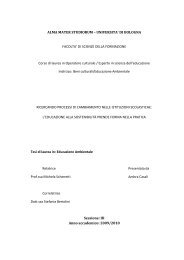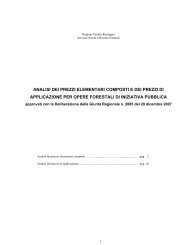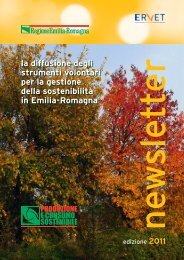air, water and soil quality qualité - ER Ambiente - Regione Emilia ...
air, water and soil quality qualité - ER Ambiente - Regione Emilia ...
air, water and soil quality qualité - ER Ambiente - Regione Emilia ...
You also want an ePaper? Increase the reach of your titles
YUMPU automatically turns print PDFs into web optimized ePapers that Google loves.
coincides with an old Uzbek proverb: «It is rich not the l<strong>and</strong> owner, but the <strong>water</strong><br />
one».<br />
The Aral Sea holds a strong impact on the regional l<strong>and</strong>scape, being Central Asia<br />
an almost completely arid territory, normally characterized by s<strong>and</strong>y deserts<br />
(Kyzylkum, Karakum) or steppe biome. Located in the middle of the Turolian<br />
lowl<strong>and</strong> between 30 <strong>and</strong> 40 m a.s.l., it receives <strong>water</strong> resources from an endorheic<br />
basin. This definition applies when, because of the orography, rivers <strong>and</strong> streams<br />
do not flow in seas or oceans, forming on the contrary inl<strong>and</strong> <strong>water</strong> bodies. The<br />
Aral Sea Basin (fig. 1) is considerably wide, reaching 1.8 million km 2 <strong>and</strong><br />
involving Kazakhstan, Uzbekistan, Turkmenistan, Tajikistan, Kyrgyzstan (until<br />
1991 included in the USSR), Afghanistan <strong>and</strong> minoritily Iran <strong>and</strong> Popular Republic<br />
of China. In this basin, Amu-Darya <strong>and</strong> Syr-Darya are the main rivers, draining the<br />
most of the superficial <strong>water</strong>s: in both cases they are exotic <strong>water</strong>courses,<br />
conveying downstream sources-originated <strong>water</strong>s, <strong>and</strong> not receiving considerable<br />
contributions from tributaries.<br />
The Amu-Darya river (Oxus in Ancient Greek <strong>and</strong> Latin literature) originates from<br />
Pamir Chain, after the confluence of Pyanj (Afghanistan) <strong>and</strong> Vakhsh (Tajikistan)<br />
rivers. Its total length exceeds 2400 km, <strong>and</strong>, thanks to 70 km 3 annual discharge, it<br />
can be considered as the Central Asian biggest river (GLANTZ, 2005). The Amu-<br />
Darya règime is strongly irregular, influenced by seasonal meltings of Afghan <strong>and</strong><br />
Tajik glaciers; its muddy <strong>water</strong>s are very rich in silt.<br />
The Syr-Darya river (Iaxartes in the Antiquity), 2300 km long, originates from<br />
Tien Shan mountains in Kyrgyzstan, crosses Tajikistan <strong>and</strong> Uzbekistan, <strong>and</strong> finally<br />
reaches Kazakhstan, where flows through a delta in the Aral Sea. Analogously to<br />
Amu-Darya, also Syr-Darya river holds an irregular règime, but its annual<br />
discharge is lesser than the first one.<br />
In the 20 th century, the ’50s meant for the USSR a u-turn in the economical field.<br />
Ceased the Stalin Era, the Soviet Union, under the guide of Nikita Kruscev,<br />
launched a new ambitious agrarian project in Central Asia: the quinquennial plan<br />
<strong>and</strong> several CPSU resolutions ratified, in the central part of the Aral Sea Basin, the<br />
development of cotton cultivation, trying to reach the self-sufficiency about this<br />
sector <strong>and</strong> become the first cotton producer in the world, exceeding the USA<br />
(ZONN, 1999). The official reasons of such an initiative were economical <strong>and</strong><br />
agrarian, but behind this operation there were also propag<strong>and</strong>a reasons within the<br />
Cold War: the USSR intended to demonstrate the superiority of the Socialist model<br />
in comparison with the Capitalist one. Moreover, the giantism of this program is<br />
connected with Soviet Union environmental policies, based on a concept of mere<br />
exploitation of natural resources, considered virtually inexhaustible <strong>and</strong> without<br />
intrinsic values, paradoxically similar to the theories of the contemporary<br />
capitalistic neoclassical economists (ZIEGL<strong>ER</strong>, 1987). Consequently, most of<br />
Uzbekistan <strong>and</strong> part of Southern Kazakhstan (at that time Republics included in the<br />
USSR) were reconverted into a cotton monocolture, collectively driven through the<br />
creation of Kolkhoz <strong>and</strong> Sovkhoz: Kolkhoz were smaller <strong>and</strong> quite similar to<br />
<br />
53



